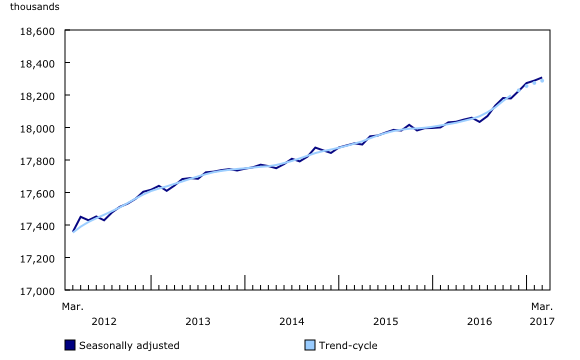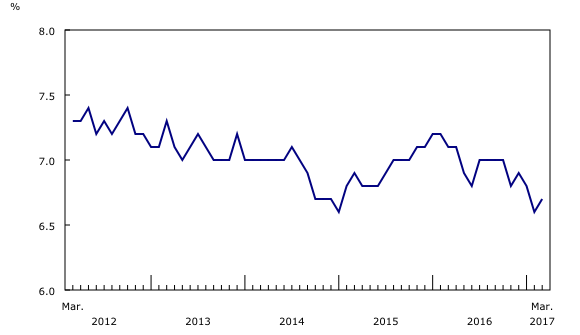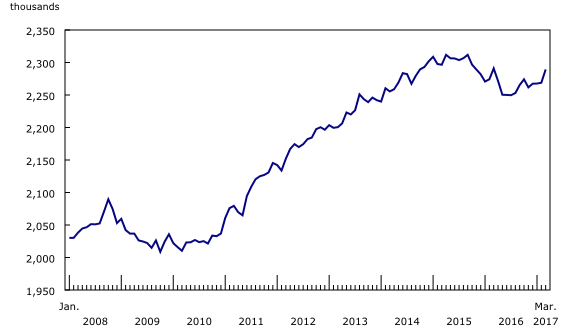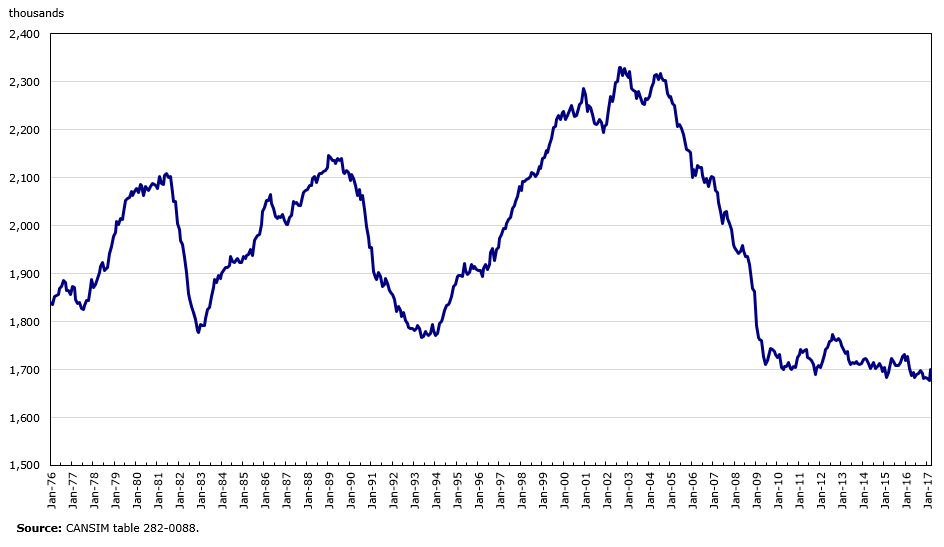Labour Force Survey, March 2017
Archived Content
Information identified as archived is provided for reference, research or recordkeeping purposes. It is not subject to the Government of Canada Web Standards and has not been altered or updated since it was archived. Please "contact us" to request a format other than those available.
Released: 2017-04-07
Employment was little changed in March (+19,000 or +0.1%), while the unemployment rate rose 0.1 percentage points to 6.7% as more people searched for work.
In the first quarter of 2017, employment gains totalled 83,000 or 0.5%. This growth is comparable to the last quarter of 2016 (+91,000 or +0.5%) and notably higher than the first quarter of 2016 (+36,000 or +0.2%).
Compared with 12 months earlier, employment increased by 276,000 (+1.5%), mostly in full-time work. Over the same period, the total number of hours worked rose 0.7%.
Highlights
In March, employment increased for men aged 25 to 54, while there was little change among other demographic groups.
Employment rose in Alberta, Nova Scotia and Manitoba. At the same time, employment fell in Saskatchewan, while it was relatively stable in the remaining provinces.
There were more people working in manufacturing; business, building and other support services; wholesale and retail trade; and information, culture and recreation. On the other hand, declines were recorded in educational services; transportation and warehousing; "other services"; and public administration.
Demographic overview
Employment rose by 35,000 among men aged 25 to 54 in March, all in full-time work. Employment for this group has been on an upward trend, with gains totalling 101,000 (+1.6%) since August. This follows virtually no growth in 2015 and the first half of 2016. The unemployment rate for core-aged men was unchanged in March, as more of them participated in the labour market. On a year-over-year basis, the unemployment rate for men aged 25 to 54 declined 0.8 percentage points to 5.8%.
Among women aged 25 to 54, employment held steady in March and the unemployment rate was virtually unchanged at 5.2%. Employment among core-aged women has been on an upward trend since the fall of 2016. Gains totalled 86,000 (+1.5%) in the 12 months to March, entirely in full-time work.
Employment among men and women aged 55 and older edged down in March. The unemployment rate for this age group rose 0.4 percentage points to 6.2%, mostly due to more women searching for work. On a year-over-year basis, employment for people aged 55 and older rose by 101,000 or 2.7%, primarily the result of the continued transition of the baby-boom cohort into this older age group.
For youths aged 15 to 24, overall employment held steady in March, as full-time work edged up while part-time employment decreased. The youth unemployment rate was down slightly from March 2016 at 12.8%. Employment was relatively unchanged for this group in the 12 months to March, despite a declining youth population (-1.0%).
Provincial summary
Employment in Alberta rose by 20,000 in March, all in full-time work. Employment in the province has been on an upward trend since the autumn of 2016, following a strong downward trend which began in 2015. The unemployment rate was little changed in March, at 8.4%, as more people participated in the labour market. This was down from a recent high of 9.0% observed in November 2016, when the unemployment rate reached a peak associated with the commodities downturn that began in 2014.
There were 4,600 more people working in Nova Scotia in March. More people also searched for work and the unemployment rate increased 0.5 percentage points to 8.6%. The level of employment and the unemployment rate were each virtually unchanged from 12 months earlier.
In Manitoba, employment increased by 2,800 and the unemployment rate decreased 0.3 percentage points to 5.5%. Employment in the province has been on a slight upward trend since November 2016, with gains totalling 8,600 (+1.4%) during that period.
Employment declined by 5,100 in Saskatchewan in March, partly offsetting an increase observed in February. The unemployment rate was unchanged at 6.0% as fewer people participated in the labour market. Compared with 12 months earlier, employment in Saskatchewan was virtually unchanged.
In March, there was little month-to-month employment change in the three most populous provinces. On a year-over-year basis, employment growth was positive in British Columbia (+3.5%), Quebec (+2.4%), and Ontario (+1.2%). An upward trend in employment among all three of these provinces was observed over the second half of 2016. In March, British Columbia continued to have the lowest unemployment rate of all provinces, at 5.4%, while Quebec and Ontario each had an unemployment rate of 6.4%.
Quarterly update for the territories
The Labour Force Survey collects labour market data in the territories, produced in the form of three-month moving averages.
In the first quarter of 2017, employment in Yukon increased by 600 compared with the fourth quarter of 2016. Over the same period, the unemployment rate was little changed at 4.4%, as more people also participated in the labour market.
Employment in the Northwest Territories declined by 700 in the first quarter of 2017 compared with the previous quarter, while the unemployment rate was little changed at 7.0%.
In Nunavut, employment fell by 500 in the first quarter of 2017 compared with the last quarter of 2016 and the unemployment rate was 15.2%.
Industry perspective
Following a downward trend in manufacturing observed throughout 2016, employment in this industry rose by an estimated 24,000 in March. This is the largest one-month increase in manufacturing since August 2002. The net effect was that employment in manufacturing was at virtually the same level as 12 months earlier. Compared with its peak in the early 2000s, there were about 630,000 (-27%) fewer people working in manufacturing, and employment in the industry has been relatively flat since the 2008-2009 recession.
There were 18,000 more people working in business, building and other support services, contributing to total gains of 31,000 (+4.2%) in the first quarter of 2017. Employment in this industry was flat for most of 2016. This industry is broad and includes administrative or cleaning services to businesses and buildings, as well as employment services.
In wholesale and retail trade, employment increased for the second consecutive month, up 17,000 in March. On a year-over-year basis, there were 51,000 (+1.9%) more people working in the industry. Wholesale and retail trade is the largest industry group by employment, comprising an estimated 2.8 million people or 15% of all workers.
Employment in information, culture and recreation rose by 11,000 in March. Compared with 12 months earlier, employment was up 32,000 (+4.2%). This industry group includes amusement and heritage industries, as well as data processing, hosting and related services.
In educational services, employment declined by 15,000 in March, spread across several provinces. Despite this decline, there was relatively no change in employment on a year-over-year basis.
Employment declined by 13,000 in transportation and warehousing, following two months of gains. On a year-over-year basis, employment in this industry was little changed.
There were 9,500 fewer people working in "other services" in March. Compared with 12 months earlier, employment in this industry was up 20,000 (+2.7%), mostly due to gains observed in the autumn of 2016. "Other services" include services related to civic and professional organizations, private households, and repair and maintenance.
In public administration, employment fell by 7,800 in March, following two months of increases. Compared with March 2016, there were 65,000 (+7.2%) more people working in public administration. Most of the year-over-year increase was in local, municipal and regional public administration.
Employment in agriculture declined by 6,900 in the month, and was down by 19,000 (-6.4%) compared with March 2016.
In March, the number of employees was little changed in both the private and public sectors. Compared with 12 months earlier, the number of private sector employees increased by 220,000 (+1.9%), while the number of public sector employees increased by 67,000 (+1.9%). Self-employment was little changed on both a monthly and year-over-year basis.

In celebration of the country's 150th birthday, Statistics Canada is presenting snapshots from our rich statistical history.
Children and the labour market around the 20th century
Historically, children made an important contribution to the economic well-being of their families. For example, data from the 1871 Census shows that children aged 15 and under made up 8% of the workforce in Ontario industrial establishments. Children were a particularly important source of labour in industries such as cotton manufacturing and tobacco manufacturing.
Beginning in Ontario in 1871, laws requiring school attendance were introduced. At the beginning of the 20th century, restrictions were placed on the age at which children could work, and regulations on the number of hours per day and the times of day that children could work were implemented. By 1911, children aged 15 and under represented 2.4% of industrial workers in Ontario.
Through the early 1900s, children's earnings remained important to the economic security of many families. In 1901, approximately one-quarter of children aged 10 to 14 lived outside of their family home as domestic servants. The 1931 Census—taken in the midst of the Great Depression— showed that, in families with low earnings, children aged 15 and over were responsible for 40% of family income.
From the inception of the Labour Force Survey in 1945 until 1975, 14-year-olds were included in estimates of employment. Since 1976, data have been reported for the population aged 15 and over, in order to monitor youth employment as well as to be consistent with international labour standards.
Sources: Darroch, G. 2007. "Families, Fostering and Flying the Coop: Lessons in Liberal Cultural Formation, 1871-1901", Household Counts: Canadian Households and Families in 1901, editors E.W. Sager and P. Baskerville, University of Toronto Press, pages 197 to 246.
Hurl, Lorna F. "Restricting Child Factory Labour in Late Nineteenth Century Ontario", Labour/Le Travail, 21 (Spring 1988): 87-121.
Pelletier, A.J., F.D. Thompson and A. Rochon. 1938. The Canadian Family, 1931 Census, monograph no. 7, Statistics Canada catalogue no. 98-1931 CM-7.
Note to readers
The Labour Force Survey (LFS) estimates for March are for the week of March 12 to 18.
The LFS estimates are based on a sample and are therefore subject to sampling variability. As a result, monthly estimates will show more variability than trends observed over longer time periods. For more information, see "Interpreting Monthly Changes in Employment from the Labour Force Survey." Estimates for smaller geographic areas or industries also have more variability. For an explanation of the sampling variability of estimates and how to use standard errors to assess this variability, consult the "Data quality" section of the publication Labour Force Information (71-001-X).
This analysis focuses on differences between estimates that are statistically significant at the 68% confidence level.
The LFS estimates are the first in a series of labour market indicators released by Statistics Canada, which includes indicators from programs such as the Survey of Employment, Payrolls and Hours (SEPH), Employment Insurance Statistics, and the Job Vacancy and Wage Survey. For more information on the conceptual differences between employment measures from the LFS and SEPH, refer to section 8 of the Guide to the Labour Force Survey (71-543-G).
The employment rate is the number of employed people as a percentage of the population aged 15 and older. The rate for a particular group (for example, youths aged 15 to 24) is the number employed in that group as a percentage of the population for that group.
The unemployment rate is the number of unemployed as a percentage of the labour force (employed and unemployed).
The participation rate is the number of employed and unemployed as a percentage of the population.
Full-time employment consists of persons who usually work 30 hours or more per week at their main or only job.
Part-time employment consists of persons who usually work less than 30 hours per week at their main or only job.
Seasonal adjustment
Unless otherwise stated, this release presents seasonally adjusted estimates, which facilitate comparisons by removing the effects of seasonal variations. For more information on seasonal adjustment, see Seasonally adjusted data – Frequently asked questions.
Chart 1 shows trend-cycle data on employment. These data represent a smoothed version of the seasonally adjusted time series, which provides information on longer-term movements, including changes in direction underlying the series. These data are available in CANSIM table 282-0087 for the national level employment series. For more information, see the StatCan Blog and Trend-cycle estimates – Frequently asked questions.
Next release
The next release of the LFS will be on May 5.
Products
A more detailed summary, Labour Force Information (71-001-X), is now available for the week ending March 18.
More information about the concepts and use of the Labour Force Survey is available online in the Guide to the Labour Force Survey (71-543-G).
Labour Market Indicators dashboard (71-607-X) launched today. This new, interactive dashboard provides easy, customizable access to key labour market indicators. Users can now configure an interactive map and chart showing labour force characteristics at the national, provincial or census metropolitan area level.
Contact information
For more information, contact us (toll-free 1-800-263-1136; 514-283-8300; STATCAN.infostats-infostats.STATCAN@canada.ca).
To enquire about the concepts, methods or data quality of this release, contact Andrew Fields (613-951-3551; andrew.fields@canada.ca), Vincent Ferrao (613-951-4750; vincent.ferrao@canada.ca) or Client Services (toll-free 1-866-873-8788; statcan.labour-travail.statcan@canada.ca), Labour Statistics Division.
- Date modified:







